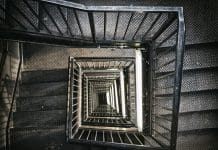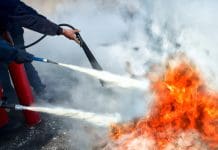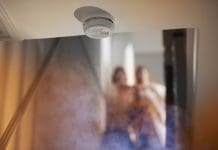FIA WG Gases Chairman Alan Elder and FIA Technical Manager Robert Thilthorpe talk to PBC Today about the FIA new guidance document, Pipework for Gaseous Fixed Fire-Fighting Systems
It has taken six months and significant input from a range of experts, but now the Fire Industry Association has published a new guidance document designed to demystify the standards surrounding the design, selection and installation of gaseous fixed fire-fighting systems pipework.
For those that don’t know, a fixed gaseous fire-fighting system is a system that does pretty much what it says on the tin – it uses a gas-based agent to put out a fire either by displacing some of the oxygen in the room to suffocate the fire, or by removing heat. The method is dependent on the type of agent used.
In almost all gaseous fixed fire-fighting system installations, the agent is delivered to the protected hazard through a network of pipework. Installing the pipework presents a number of challenges and ensuring it is correctly designed and specified is important to avoid issues that could affect the safety and effectiveness of the system. The key thing is knowing what problems there could be and knowing how to avoid those common pitfalls.
Alan Elder, Chairman of the FIA’s Working Group Gases, explained: “The supply of gaseous fixed fire-fighting systems requires a number of skills, experience and specific knowledge of the equipment, design codes and the hazards associated with handling high-pressure gases. People need to understand how to install gaseous systems so that the system is not only operational, but safe.”
Safety is the key issue that has inspired the FIA’s WG Gases to create a series of useful, freely downloadable documents designed to explain the key safety concerns to those working with, handling and installing these systems.
The latest in the series of documents, the FIA Guidance Note, Pipework for Gaseous Fixed Fire Fighting Systems, contains an expanse of information based on the technical knowhow from the experts who prepared it and includes handy referral charts and formulas for working out which pipes should be selected.
“There are a number of concerns in the industry, especially when it comes to pipework,” explained Elder.
“One of the big concerns is that people can mix up British and American standards. It can happen accidentally as there are standards for pipes in the UK that are different to the ones in the USA.
“People do not necessarily realise that pipe fittings manufactured to British standards may not be compatible with fittings manufactured to American standards. It is entirely possible that one installer may be familiar with American standards and another familiar with British standards – and if components are mixed on the same system then there could be some compatibility issues between the different types of fittings, which could lead to a decrease in the integrity of the system as a whole.”
Elder was keen to stress the importance of sticking to just one standard for any given system and ensuring that the standards are applied consistently.
“Pipework and fittings may be suitable for one type of gas system, but they might not be suitable for another,” he added.
“Fortunately, with the new guidelines that we have created, it is our intention to help to educate the industry and reduce any confusion surrounding the pipework.
“We really need people to understand that working with gas requires a highly specialised skillset and an understanding of how gas reacts and moves within a pressurised environment.”
The guide states that it is “important that the pipework from the container storage location to the protected space is professionally installed by trained personnel, who have experience with the installation of gaseous fixed fire-fighting systems. They should also be fully conversant with the manufacturer’s requirements to ensure the integrity and stability of piping during discharge and aware of the forces generated. Where agent storage containers are located outside the protected space then the pipe routing should be the shortest route possible to the protected space.”
Thankfully, the document has a handy chart for installers and designers of gaseous fixed fire-fighting systems to refer to, which gives the measurements for the maximum spacing between the supporting hangers, depending on the nominal pipe size, which with the correct selection of the support should prevent any pipes from coming away from the wall and causing any damage.
In summary, the guidance document covers everything a designer or installer of gaseous fixed fire-fighting systems needs to know – the pipe specification for both the actuation lines and the pipework installation, methodologies for connecting the pipes, how to join and seal the pipes, what type of support to use to fix the pipes to the structure, how to avoid corrosion, marking, earth bonding and testing of the completed pipework installation.
The guidance document is available to download free of charge from the FIA’s website. Simply go to fia.uk.com, click the Resources section and search the publications library for “FIA Guidance Pipe work for Gaseous Fixed Fire Fighting Systems”, which also contains all the other guidance documents produced by FIA Working Group Gases.
Alan Elder
Chairman, Working Group Gases
Robert Thilthorpe
Technical Manager
Fire Industry Association (FIA)
Tel: +44 (0)203 166 5002
Twitter: @FireIndustry

















